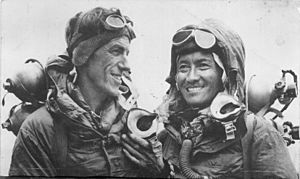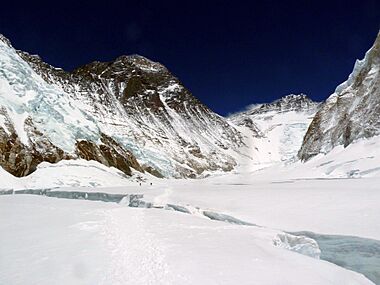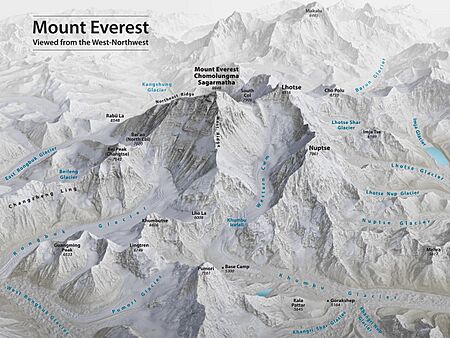1953 British Mount Everest expedition facts for kids
The 1953 British Mount Everest expedition was a famous adventure. It was the ninth try to climb Mount Everest, the world's highest mountain. This expedition was the first to successfully reach the top! Tenzing Norgay and Edmund Hillary made history on May 29, 1953. Colonel John Hunt led the team. The news of their success reached London just in time. It was announced on June 2, 1953, the same day Queen Elizabeth II was crowned.
Contents
The Journey to Everest
Early Attempts and New Routes
Mount Everest was found to be the world's tallest mountain in the 1850s. People soon became very interested in climbing it. But its huge height made many wonder if it was even possible. Early attempts to climb Everest mostly started from the north side, in Tibet. However, this route became closed later on.
Climbers then began looking at a new way to reach the summit. This new path was from the Nepal side. In 1952, a Swiss team tried climbing from Nepal. They set a new height record, reaching very close to the top. This showed that climbing from Nepal was a real possibility.
Getting Ready for the Climb
John Hunt, a British Army Colonel, was chosen to lead the 1953 British Everest expedition. He was picked because of his strong leadership skills. Many climbers from earlier expeditions joined his team. The British felt a lot of pressure to succeed. Other countries were also planning their own Everest climbs.
The team trained hard in the snowy mountains of Wales. They practiced their climbing skills. They also tested their special oxygen equipment. This equipment was very important for breathing high up on the mountain.
The team left England in February. They traveled by ship to India, then continued to Nepal. In Kathmandu, the capital of Nepal, they met the Sherpas. These local guides were very important for the expedition. They helped carry heavy loads and knew the mountains well. Tenzing Norgay was the leader of the Sherpas. He was a very experienced climber. This was his sixth time trying to climb Everest.
The Climb to the Top
Setting Up Camps
The first group reached Base Camp on April 12, 1953. Base Camp was at 17,900 feet (5,455 meters). The team then spent days setting up a path through the dangerous Khumbu Icefall. After this, Sherpas moved tons of supplies up the mountain.
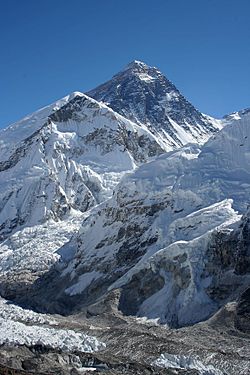
They set up a series of advanced camps higher and higher. Camp II was at 19,400 feet. Camp III was at 20,200 feet. Camp IV, the Advance Base, was at 21,000 feet. They kept moving up, establishing Camp V at 22,000 feet. Then Camp VI at 23,000 feet. Finally, Camp VII was set up at 24,000 feet. By May 21, two climbers reached the South Col, which is almost 26,000 feet high.
The First Try
The first two climbers chosen to try for the summit were Tom Bourdillon and Charles Evans. They started their climb on May 26. They successfully reached the South Summit, which is 28,700 feet (8,750 meters) high. This was very close to the main summit.
However, they faced problems with their oxygen equipment. One of Evans's oxygen sets had a damaged part. Even after fixing it, his breathing was very difficult. They were also running out of time. Because of these issues, they had to turn back. They were only about 330 feet (100 meters) from the final summit.
Hillary and Tenzing's Success
On May 27, the expedition made its second attempt. This time, it was Edmund Hillary from New Zealand and Tenzing Norgay from Nepal. Tenzing had already climbed to a record height on Everest in 1952.
They left their camp at 6:30 AM on May 29, 1953. They reached the South Summit at 9:00 AM. Then, at 11:30 AM, they finally stood on the very top of Mount Everest! They took photos and buried some sweets and a small cross in the snow. Hillary later said that without his oxygen, his hands became clumsy. When they returned, Hillary told George Lowe, "Well, George, we did it!"
Sharing the Big News
The news of their success was very important. Jan Morris, a reporter for The Times newspaper, heard the news at Base Camp on May 30. She sent a secret message by a runner. The runner took the message to a town where it could be sent as a telegram.
The message was coded so no one would know the secret too early. "Snow conditions bad" meant the summit had been reached. "Advanced base abandoned" meant Hillary. "Awaiting improvement" meant Tenzing. The news reached London just in time. It was announced on the morning of June 2, the same day Queen Elizabeth II was crowned. This made the news even more exciting for the British people. The Everest climb was one of the last big news stories to be delivered by a runner!
After the Climb
Heroes Honored
When the team returned to Kathmandu, they learned about their honors. Edmund Hillary was made a Knight, so he became Sir Edmund Hillary. John Hunt was also made a Knight, becoming Sir John Hunt. This was to recognize their amazing efforts.
The Government of Nepal held a party for the team. Tenzing received a large sum of money. Hillary and Hunt received special knives called kukris with fancy covers. Other team members also received awards. The Indian government also created a new medal for bravery. Hunt, Hillary, and Tenzing were the first to receive it. Tenzing was later given the George Medal by Queen Elizabeth II.
Many other awards followed for the team members. These included medals from important geographical societies. Universities also gave them special degrees. A film about the climb, called The Conquest of Everest, was also made. It was even nominated for an Academy Award!
Who Reached First?
After the climb, many people wondered who had actually stepped on the summit first. Was it Hillary or Tenzing? Both men said it was a team effort. But Tenzing later wrote in his book that Hillary was the first to reach the very top. Hillary also described climbing the last part of the mountain. He said he cut steps in the snow and ice. Then, with Tenzing's help, he climbed to the top. "It was 11:30 a.m. and we were on top of Everest!" he wrote.
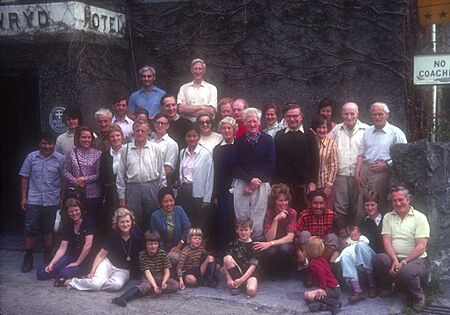
The Expedition Team
The people on the expedition were chosen for their climbing skills. They also had other important skills. Most were from the United Kingdom. But some were from other countries like New Zealand and Nepal. The leader, John Hunt, was born in India.
| Name | Role | Job | Age (at selection) |
|---|---|---|---|
| Expedition leader and climber | British Army Colonel | 42 | |
| Deputy leader and climber | Physician | 33 | |
| Climber | Geology student | 23 | |
| Climber | Physicist | 28 | |
| Climber | Travel agency director | 39 | |
| Climber | Schoolmaster and author | 34 | |
| Doctor and climber | Physiologist | 43 | |
| Cameraman and climber | Cameraman | 38 | |
| Expedition doctor and climber | Physician | 27 | |
| Climber | Statistician | 27 | |
| Organizer and climber | Soldier | 32 | |
| Climber | Beekeeper | 33 | |
| Climber | Schoolmaster | 28 | |
| Climber and guide | 38 | ||
| Climber and guide |
The climbers were joined by Jan Morris, a reporter. There were also 362 porters. In total, the expedition had over four hundred people. This included twenty Sherpa guides from Tibet and Nepal. They carried a huge amount of gear, weighing ten thousand pounds!
See also
 In Spanish: Expedición británica al Everest de 1953 para niños
In Spanish: Expedición británica al Everest de 1953 para niños
- Hillary Step
- Timeline of climbing Mount Everest
- List of 20th-century summiters of Mount Everest


